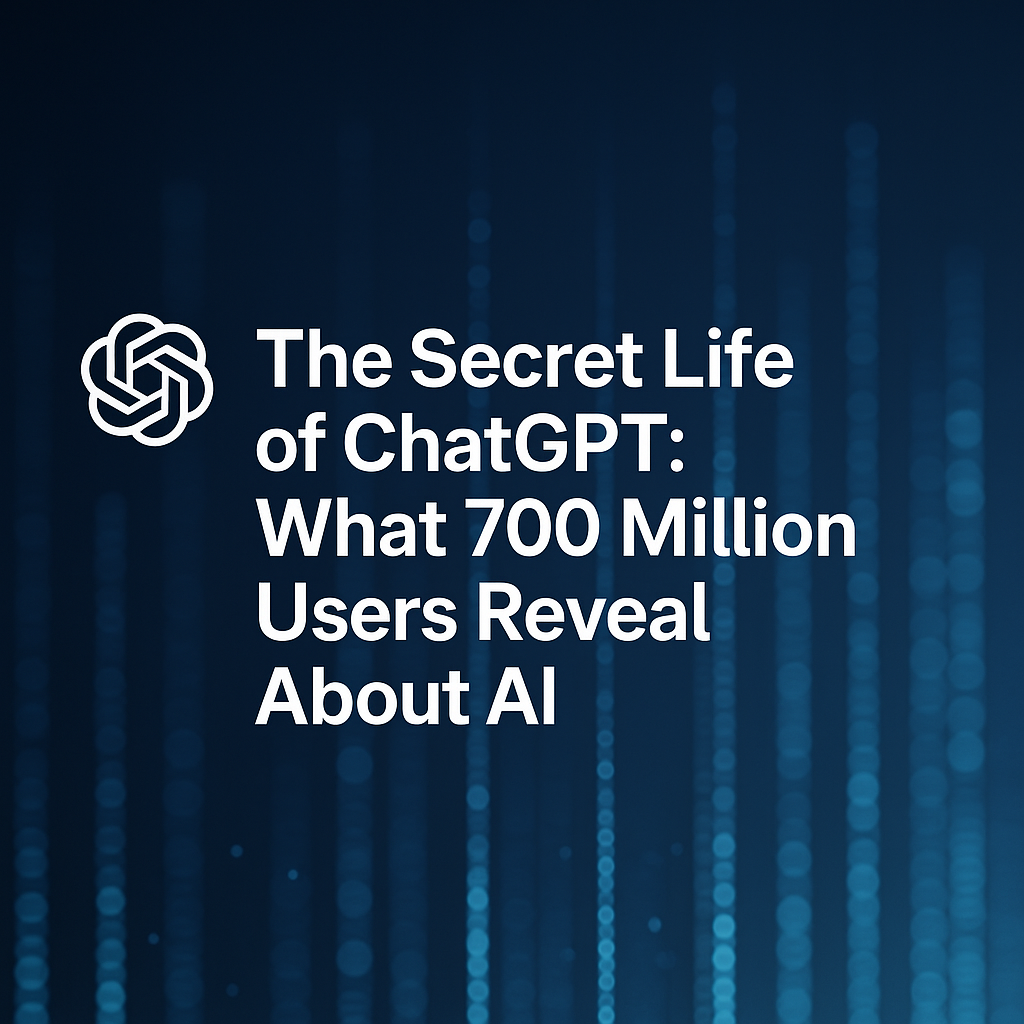
Article Banner — This image is AI generated, looks great right! I suck at Canva (imagine that)
The ideal topic would have been:
The Secret Life of ChatGPT: What 700 Million Users Reveal About AI
but that feels too “AI” generated.
(another but …) but first
Nerds for Stats
| Category | Statistic |
|---|---|
| Adoption | 700M weekly active users (WAU) by July 2025 (~10% of world’s adult population) |
| Message Volume | 18B messages per week (~2.5B per day) by July 2025 |
| Growth Factor | 5× increase in daily messages between Jul 2024 and Jul 2025 |
| Work vs Non-Work (Jun 2024) | 238M non-work (53%), 213M work (47%) per day |
| Work vs Non-Work (Jun 2025) | 1.91B non-work (73%), 716M work (27%) per day |
| Main Usage Categories | Practical Guidance, Seeking Information, Writing = ~80% of all conversations |
| Writing Use | 40% of work-related messages; ⅔ editing/critique/translation vs ⅓ generating new text |
| Tutoring/Education | ~10% of all messages |
| Programming | 4.2% of all messages (contrast: ~33% of Claude’s work-related conversations) |
| Relationships/Companionship | 1.9% (personal reflection), 0.4% (games/role play) |
| Interaction Types | Asking = 49%, Doing = 40%, Expressing = 11% |
| Work-Specific Breakdown | 56% of work-related = Doing; ~75% of those are Writing tasks |
| Work Activities (O*NET) | 81% of work use = (1) getting/interpreting info, (2) making decisions/solving problems/creative thinking |
| Demographics – Gender | Early (2022): ~80% male names. By Jun 2025: 48% male, slight female majority |
| Demographics – Age | ~50% of all messages from users <26 years old |
| Geography | Faster growth in low- and middle-income countries |
| Economic Value | Estimated consumer surplus ≥ $97B in 2024 (U.S. alone) |
Oooh and if you hate numbers, I have some good graphs for you …
Visualizing the Findings
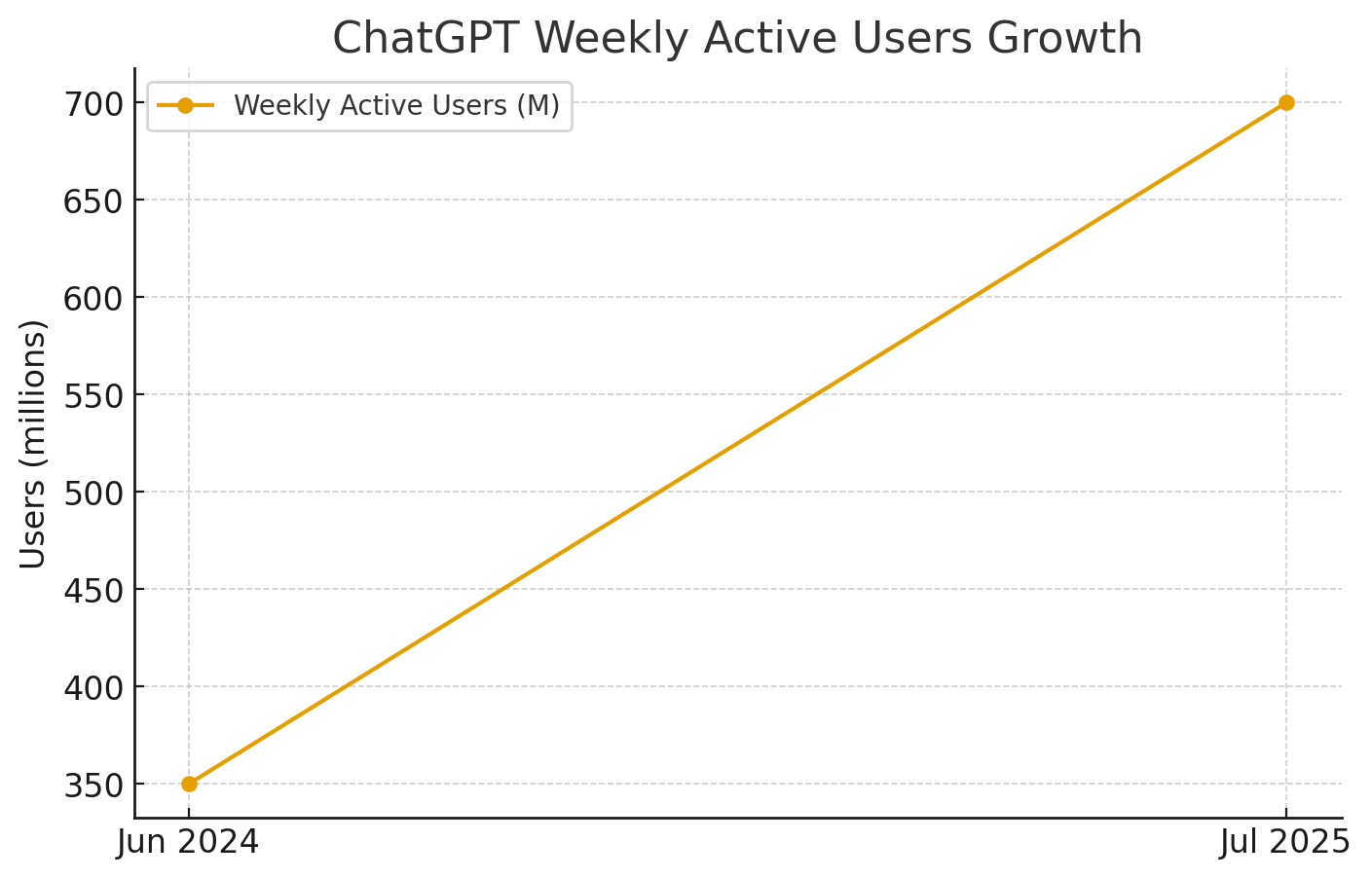
Global adoption growth for ChatGPT, 2022–2025
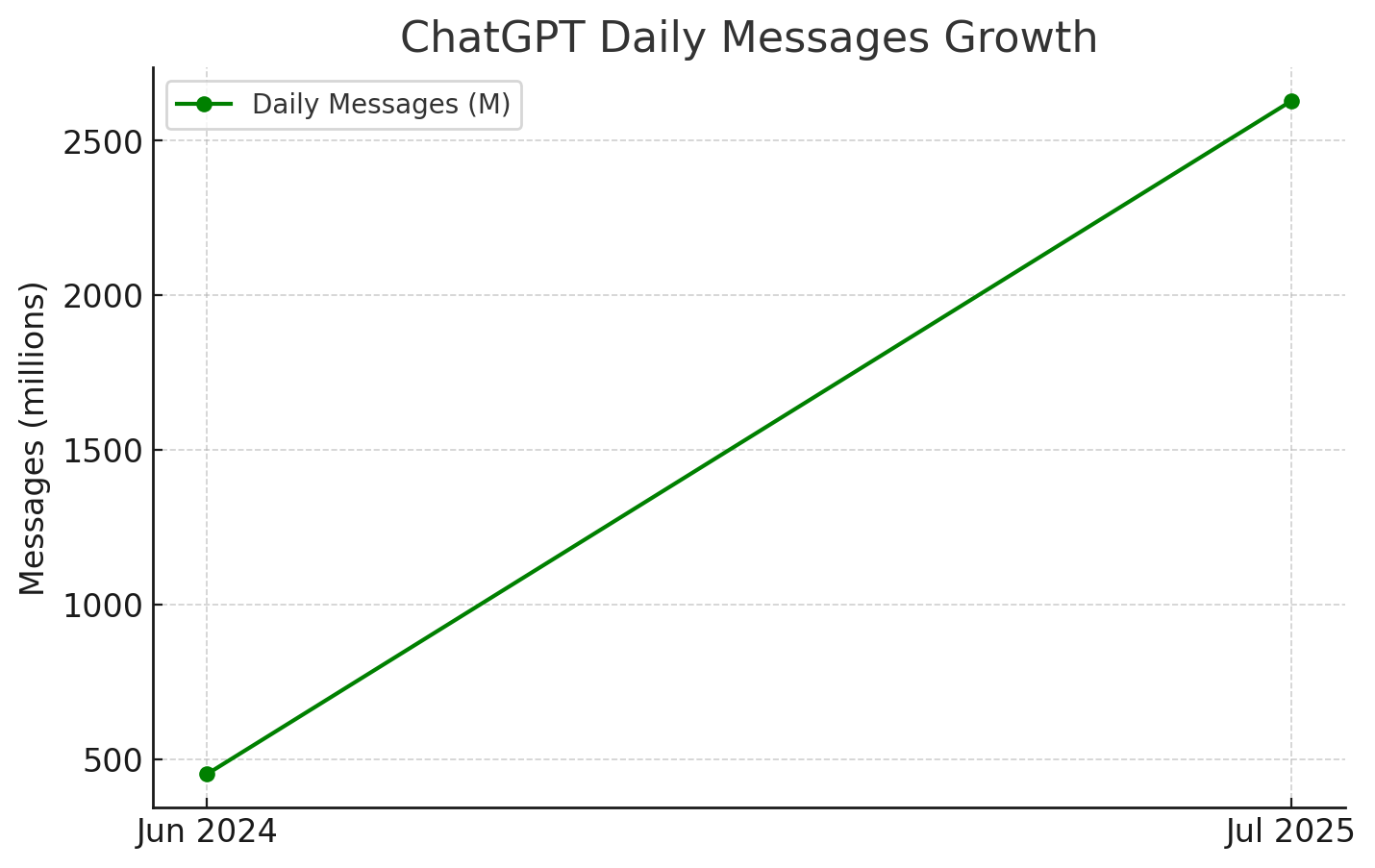
Daily message volume and growth across 2024–2025
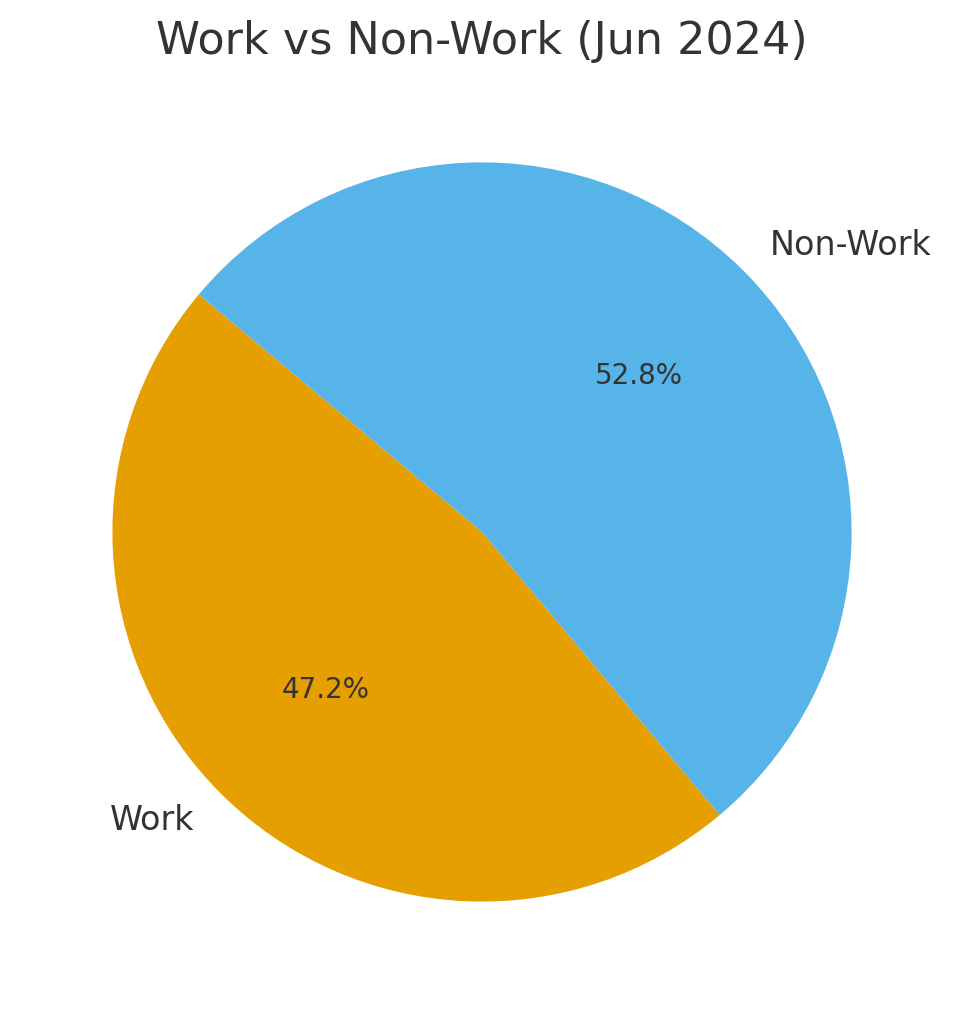
Share of major usage categories over time

Work conversations skew toward writing-heavy tasks

User satisfaction trends by model release
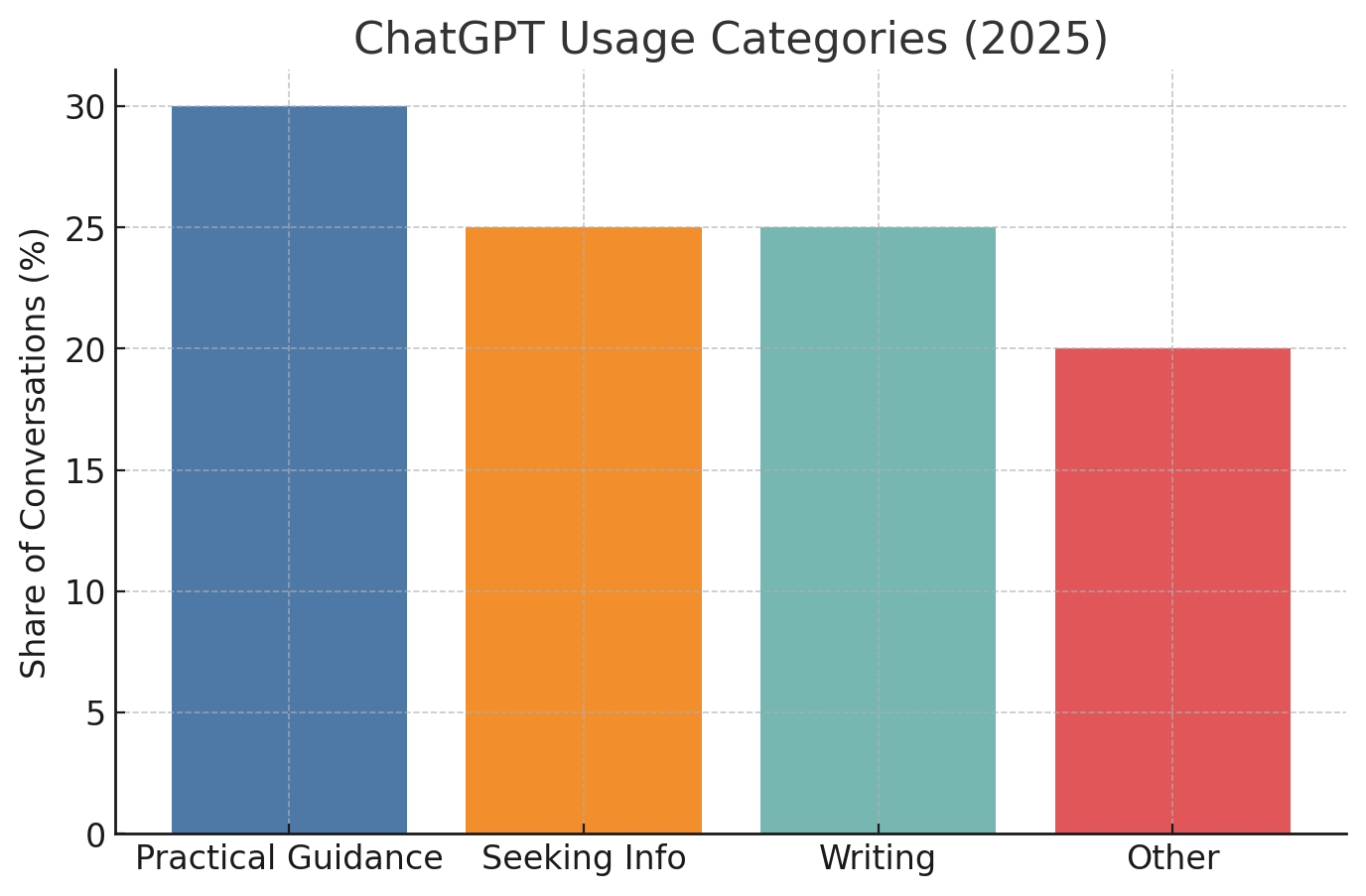
Privacy-preserving research pipeline for ChatGPT usage
(serious mode …)
Since exploding onto the scene in late 2022, ChatGPT has become a global phenomenon. But beyond the headlines and hype, what are people actually doing with it?
Let’s dive into the key learnings from this massive study.
The ChatGPT Rush: It’s Not Just for Tech Bros Anymore(sadly)
The growth has been nothing short of historic. By July 2025, ChatGPT was being used by 700 million people every week—that’s about 10% of the entire adult population of the planet. But more fascinating than the raw numbers is who these users are.
The Gender Gap Has Vanished: In its early days, ChatGPT was a bit of a boys’ club, with around 80% of early adopters having typically masculine first names. But that has changed dramatically. As of June 2025, the user base has reached near-parity, with users having typically feminine names now slightly outnumbering those with masculine names.
A Global Phenomenon: While early adoption was stronger in wealthier nations, the past year has seen explosive growth in low- and middle-income countries. This suggests AI is not just a tool for the developed world but is rapidly becoming a global utility.
Youth Leads the Way: Younger users are the most prolific, with people under the age of 26 accounting for nearly half of all messages sent by adults.
The Biggest Surprise: It’s More About Life Than Work
While most discussion around AI focuses on workplace productivity, the data tells a different story. The study found that non-work related usage is not only the majority but is also growing much faster than work-related use. In June 2024, non-work messages made up 53% of the total; just one year later, that figure soared to over 70%.
This suggests that for most people, ChatGPT’s greatest value lies in what economists call “home production”—helping us manage our daily lives, learn new things, and satisfy our curiosity.
So, What’s Everyone Actually Doing?
The research team classified conversations into broad topics and found that nearly 80% of all usage falls into three main categories:
Practical Guidance (29%): This is the single biggest use case and includes everything from getting customized workout plans to tutoring on complex subjects and brainstorming creative ideas. A significant chunk of this—about 10% of all messages—is for tutoring and teaching, making education a key application.
Writing (24%): This involves generating and, more often, refining text. Interestingly, two-thirds of all “Writing” tasks involve modifying existing text—like summarizing, editing, or translating—rather than creating something new from scratch.
Seeking Information (24%): This category, which has grown rapidly, covers tasks similar to a traditional search engine, like looking up facts, people, or recipes.
What to Watch Out For: AI Replacing Developers Myth
The data also pours some cold water on popular narratives. Despite fears of AI replacing programmers, computer programming accounts for a surprisingly small 4.2% of messages. Similarly, the idea of AI as a primary source for companionship or therapy isn’t strongly supported by this data, with “Relationships and Personal Reflection” making up just 1.9% of use.
Getting Down to Business: A Thinking Partner for Professionals
When people do use ChatGPT for work, it’s a specific slice of the workforce. Usage is much higher among highly educated users in professional and technical occupations like management, computer science, and engineering.
For these professionals, Writing is the undisputed king of work tasks, making up 40% of all work-related messages. This is especially true for those in management and business, where it accounts for over half their use.
The study introduces a fascinating framework for work usage: are people “Doing” a task (like drafting an email) or “Asking” for information to make a decision?
- “Doing” (task completion) accounts for about 56% of work messages.
- “Asking” (decision support) accounts for about 35%.
Crucially, users in knowledge-intensive professional jobs are far more likely to use ChatGPT for “Asking”. This suggests they value it less as a digital intern and more as a co-pilot for their brain—a tool that helps them solve problems and make better decisions, which is where its true economic value may lie.
Is It Actually Getting Better? (The Data Says Yes.)
The platform is constantly evolving with new and improved models like GPT-4o and GPT-5. The research confirms that these improvements are having a real impact on user satisfaction. An automated classifier rated interactions as “Good,” “Bad,” or “Unknown” based on user follow-up messages. The findings were clear: the number of “Good” interactions grew far more rapidly than “Bad” ones, suggesting a tangible improvement in quality over time.
Notably, “Asking” queries consistently received higher satisfaction ratings than “Doing” queries, reinforcing the idea that decision support is a highly valued feature.
A Final Note on Privacy
One of the most important aspects of this research is how it was conducted. To protect user privacy, the researchers never looked at the content of any message. Instead, they developed a novel privacy-preserving pipeline, using LLM-based classifiers to automatically categorize conversations and analyzing sensitive demographic data within a secure “data clean room” where only aggregated results were visible. This sets a strong precedent for conducting large-scale AI research responsibly.